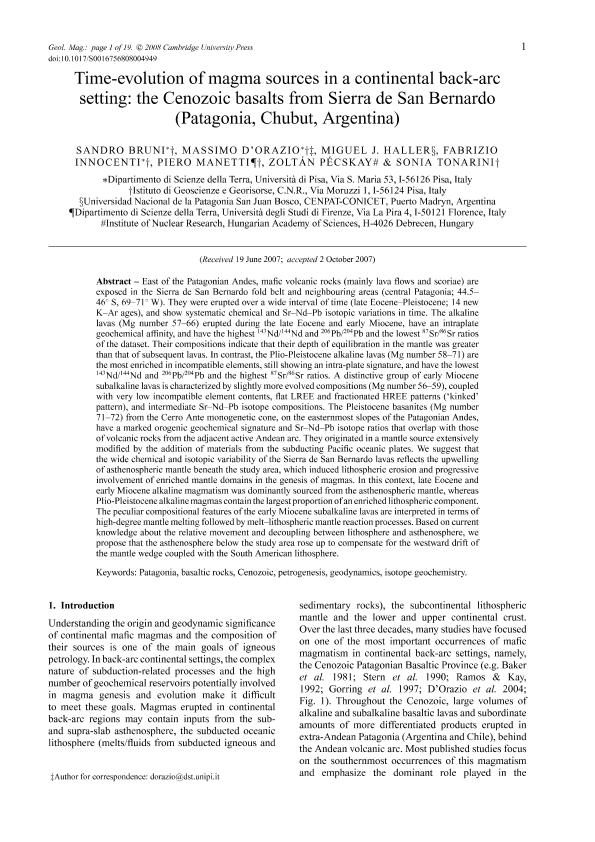Mostrar el registro sencillo del ítem
dc.contributor.author
Bruni, Sandro
dc.contributor.author
D'Orazio, Massimo
dc.contributor.author
Haller, Miguel Jorge F.

dc.contributor.author
Innocenti, Fabrizio
dc.contributor.author
Manetti, Piero
dc.contributor.author
Pécskay, Zoltán
dc.contributor.author
Tonarini, Sonia
dc.date.available
2020-03-18T20:42:43Z
dc.date.issued
2008-12
dc.identifier.citation
Bruni, Sandro; D'Orazio, Massimo; Haller, Miguel Jorge F.; Innocenti, Fabrizio; Manetti, Piero; et al.; Time-evolution of magma sources in a continental back-arc setting: The Cenozoic basalts from Sierra de San Bernardo (Patagonia, Chubut, Argentina); Cambridge University Press; Geological Magazine; 145; 5; 12-2008; 714-732
dc.identifier.issn
0016-7568
dc.identifier.uri
http://hdl.handle.net/11336/100132
dc.description.abstract
East of the Patagonian Andes, mafic volcanic rocks (mainly lava flows and scoriae) are exposed in the Sierra de San Bernardo fold belt and neighbouring areas (central Patagonia; 44.5-46° S, 69-71° W). They were erupted over a wide interval of time (late Eocene-Pleistocene; 14 new K-Ar ages), and show systematic chemical and Sr-Nd-Pb isotopic variations in time. The alkaline lavas (Mg number 57-66) erupted during the late Eocene and early Miocene, have an intraplate geochemical affinity, and have the highest 143Nd/144Nd and 206Pb/204Pb and the lowest 87Sr/ 86Sr ratios of the dataset. Their compositions indicate that their depth of equilibration in the mantle was greater than that of subsequent lavas. In contrast, the Plio-Pleistocene alkaline lavas (Mg number 58-71) are the most enriched in incompatible elements, still showing an intra-plate signature, and have the lowest 143Nd/ 144Nd and 206Pb/204Pb and the highest 87Sr/86Sr ratios. A distinctive group of early Miocene subalkaline lavas is characterized by slightly more evolved compositions (Mg number 56-59), coupled with very low incompatible element contents, flat LREE and fractionated HREE patterns ('kinked' pattern), and intermediate Sr-Nd-Pb isotope compositions. The Pleistocene basanites (Mg number 71-72) from the Cerro Ante monogenetic cone, on the easternmost slopes of the Patagonian Andes, have a marked orogenic geochemical signature and Sr-Nd-Pb isotope ratios that overlap with those of volcanic rocks from the adjacent active Andean arc. They originated in a mantle source extensively modified by the addition of materials from the subducting Pacific oceanic plates. We suggest that the wide chemical and isotopic variability of the Sierra de San Bernardo lavas reflects the upwelling of asthenospheric mantle beneath the study area, which induced lithospheric erosion and progressive involvement of enriched mantle domains in the genesis of magmas. In this context, late Eocene and early Miocene alkaline magmatism was dominantly sourced from the asthenospheric mantle, whereas Plio-Pleistocene alkaline magmas contain the largest proportion of an enriched lithospheric component. The peculiar compositional features of the early Miocene subalkaline lavas are interpreted in terms of high-degree mantle melting followed by melt-lithospheric mantle reaction processes. Based on current knowledge about the relative movement and decoupling between lithosphere and asthenosphere, we propose that the asthenosphere below the study area rose up to compensate for the westward drift of the mantle wedge coupled with the South American lithosphere.
dc.format
application/pdf
dc.language.iso
eng
dc.publisher
Cambridge University Press

dc.rights
info:eu-repo/semantics/openAccess
dc.rights.uri
https://creativecommons.org/licenses/by-nc-sa/2.5/ar/
dc.subject
BASALTIC ROCKS
dc.subject
CENOZOIC
dc.subject
GEODYNAMICS
dc.subject
ISOTOPE GEOCHEMISTRY
dc.subject
PATAGONIA
dc.subject
PETROGENESIS
dc.subject.classification
Geología

dc.subject.classification
Ciencias de la Tierra y relacionadas con el Medio Ambiente

dc.subject.classification
CIENCIAS NATURALES Y EXACTAS

dc.title
Time-evolution of magma sources in a continental back-arc setting: The Cenozoic basalts from Sierra de San Bernardo (Patagonia, Chubut, Argentina)
dc.type
info:eu-repo/semantics/article
dc.type
info:ar-repo/semantics/artículo
dc.type
info:eu-repo/semantics/publishedVersion
dc.date.updated
2020-03-16T15:07:02Z
dc.journal.volume
145
dc.journal.number
5
dc.journal.pagination
714-732
dc.journal.pais
Reino Unido

dc.journal.ciudad
Cambridge
dc.description.fil
Fil: Bruni, Sandro. Istituto Di Geoscienze E Georisorse; Italia. Università degli Studi di Pisa; Italia
dc.description.fil
Fil: D'Orazio, Massimo. Università degli Studi di Pisa; Italia. Istituto Di Geoscienze E Georisorse; Italia
dc.description.fil
Fil: Haller, Miguel Jorge F.. Consejo Nacional de Investigaciones Científicas y Técnicas. Centro Nacional Patagónico; Argentina. Universidad Nacional de la Patagonia "San Juan Bosco"; Argentina
dc.description.fil
Fil: Innocenti, Fabrizio. Università degli Studi di Pisa; Italia. Istituto Di Geoscienze E Georisorse; Italia
dc.description.fil
Fil: Manetti, Piero. Istituto Di Geoscienze E Georisorse; Italia. Università degli Studi di Firenze; Italia
dc.description.fil
Fil: Pécskay, Zoltán. Hungarian Academy of Sciences. Institute of Nuclear Research; Hungría
dc.description.fil
Fil: Tonarini, Sonia. Istituto Di Geoscienze E Georisorse; Italia
dc.journal.title
Geological Magazine

dc.relation.alternativeid
info:eu-repo/semantics/altIdentifier/doi/http://dx.doi.org/10.1017/S0016756808004949
dc.relation.alternativeid
info:eu-repo/semantics/altIdentifier/url/https://www.cambridge.org/core/journals/geological-magazine/article/timeevolution-of-magma-sources-in-a-continental-backarc-setting-the-cenozoic-basalts-from-sierra-de-san-bernardo-patagonia-chubut-argentina/12D110184C011E6F46161DAC6857AE3F
Archivos asociados
